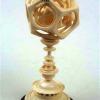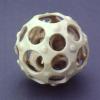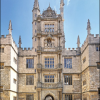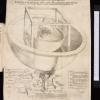The five orders and the five platonic solids: 'Mathematical Model', 1620
Commentary
In 1620 Henry Savile began the lectures that inaugurated his new Oxford professorships of geometry and astronomy. The professors were based in the Bodleian Library’s Tower of the Five Orders. In the same year Clement Edmondes, a diplomat and municipal official of London, donated this ‘mathematical model’ to the library. The alabaster sculpture combines geometry and architecture. Each side of the central column contains a rusticated version of one of the five architectural orders, with the fragmentary remains of the five Euclidean regular solids around the base. The whole is surmounted by a large dodecahedron, to which Plato had ascribed cosmological significance as reflecting the structure of the heavens. The model acts as a sort of symbolic and pedagogical machine, with the correspondence between the five geometrical solids and the five architectural orders providing part of the work’s basic conceit.
Image. Museum of the History of Science, University of Oxford, Inventory No. 90861.
Commentary. From Anthony Gerbino and Stephen Johnston, Compass and Rule: Architecture as Mathematical Practice in England, 1500-1750, a virtual exhibition at the History of Science Museum, Oxford. More detail can be found in their book of the same title (New Haven, 2009), pp. 72-9; and Alexander Marr, '"Curious and Useful Buildings": The Mathematical Model of Sir Clement Edmondes', Bodleian Library Record, 18, no. 2 (2004), 108-50.





